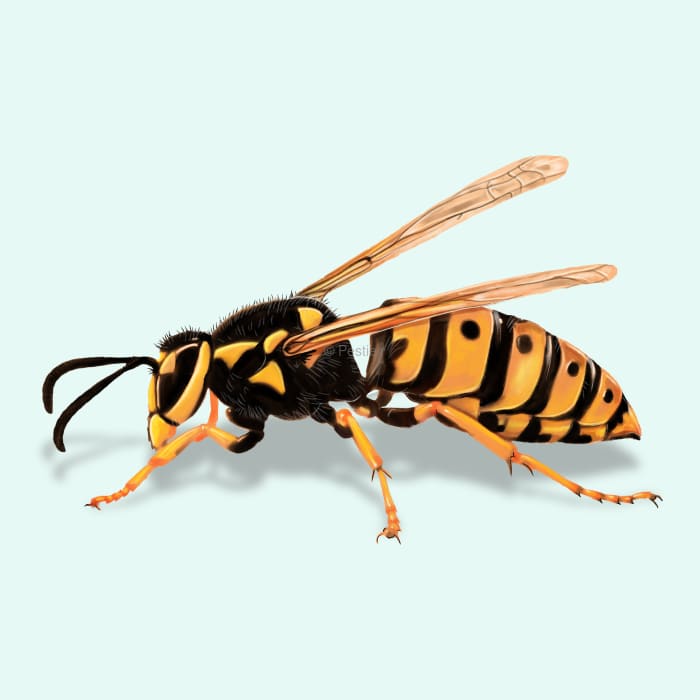How to identify and get rid of yellowjackets

Keeping yellowjackets out of your space
If you’ve ever left a can of soda too long in the summer sun, not only does your beverage become too hot to drink, but it could hold a little surprise inside, too. Many picnics have been ruined by the sudden appearance of yellowjackets looking to join in on your sugary treats and grilled meats.
These ground-dwelling pests get aggressive if you come too close to their nest. However, since their nests are easily concealed in the ground, you could be right on top of it without even noticing it!
Yellowjackets prefer to make their nests in abandoned rodent burrows, but they will also settle for attics, crawlspaces, or under a deck. The nests are founded by a single queen and will die off during winter.
The adult wasps will feed on sugary foods, like fruit, nectar, tree sap, or a left-out soda can. However, larvae need more protein in their diet, so yellowjackets will also hunt for caterpillars and insects or harvest meat from dead animal carcasses.
How to identify yellowjackets
Yellowjackets can be identified by their distinctive yellow and black coloring and aggressive behavior, especially near food sources or nests. They will also have a thin waist between their thorax and abdomen. At the end of that abdomen is a stinger that can sting multiple times, unlike the barbed stinger of honey bees.
Additionally, yellowjackets will have strong mandible jaws that they use to tear and chew up wood fibers and insect prey for their larvae.
How big are yellowjackets?
Adult yellowjackets are typically around 1/2 inch long, with queens being slightly larger, up to 3/4 inch.
What other insects look like a yellowjacket?
Many wasps, hornets, and bees can be mistaken for yellowjackets. However, they differ in their nesting habits and behavior. Yellowjackets are more aggressive and likely to be found scavenging near human activity. They aren’t fuzzy like bees or have long, thin waists like wasps and are smaller than hornets.
Where do yellowjackets live?
Yellowjackets are found throughout the eastern United States, mostly in woodlands, pastures, parks, lawns, and more urban areas. They will make their nests in the ground, but they can sometimes make them in wall voids, thick mulch piles, rotted tree trunks, and other protected cavities.
How to get rid of yellowjackets
Try to pinpoint where the nest is in your yard or lawn. Avoiding this area until the nest can be dealt with properly is best. If you decide to get rid of the nest, you need to be very cautious about how you will do it, and make sure to do it at night when the yellowjacket activity is low. You can then spray a pesticide like pyrethrum into the nest or boiling water poured into the nest. These are still risky treatments and should be done with extreme caution. It may be better for you to use a professional to remove the nest. This can often be done with vacuums or pesticide treatments.
Leaving the nest alone until the first hard freeze will eliminate the problem if you can manage it. Yellowjackets can’t tolerate cold temperatures, and the nest lasts only one season. Eliminating rodent burrows in your yard can reduce the chances that yellowjackets will build a nest in your yard.
If you can’t find the nest but still have yellowjackets visiting your property, one of the best ways to prevent yellowjackets from coming into your home is by spraying and maintaining a bug-barrier. With the Pestie Smart Pest Plan, you’ll get a pro-grade, DIY solution delivered right to your door so you can enjoy a pest-free home year-round.
Treat yellowjackets with Pestie
If you're still having trouble keeping yellowjackets away, the best option is to use a pro-grade, effective pest control solution like Pestie.
Pestie is a do-it-yourself pest control solution that's specially designed to keep yellowjackets and other pests away from your home.
With Pestie, you can rest easy knowing that your living space is protected and free of creepy crawlies. And the best part? It's designed for people, pets, and the planet, so you can say goodbye to harsh chemicals and hello to peace of mind!
- Save hundreds compared to traditional annual pest plans
- People, pet, and planet-friendly
- Pro-grade customized formulas
Quick facts
How dangerous are Yellowjackets?
Medium danger risk
Yellowjackets are often aggressive if you get too close, and their ability to sting multiple times can be painful and potentially dangerous to allergic individuals.
- Scientific name
Generas: Vespula and Dolichovespula
- Colors
Yellow and black
- Life span
A few months to one year
- Diet
Sugary sweets, insects, meat
Pharmaceutical companies have researched and used venom from yellowjackets to treat allergic reactions. The proteins in the venom are used to improve diagnosing venom allergies and to design treatments that can prevent severe allergic reactions.








